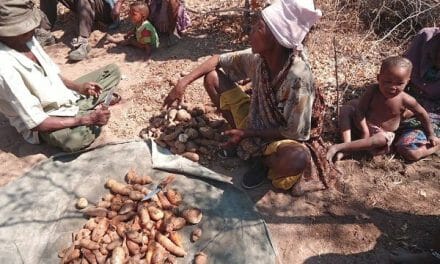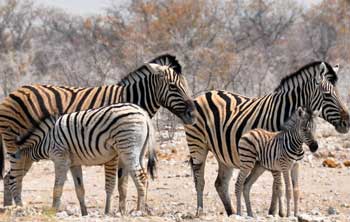
Water points for communal areas

Deputy Permanent Secretary for Water Affairs Abraham Nehemia; Deputy Minister of Agriculture, Water and Forestry Lempy Lucas; Millenium Challenge Account Deputy CEO Dr Eline van der Linden and agriculture director of the Millennium Challenge Account (MCA), Dr Helmke von Bach at the launch of the water report. (Photograph by Freeman Ngulu)
The Deputy Minister of Agriculture, Water and Forestry Lempy Lucas launched the CBRLM water report last week at the ministry’s head office in Windhoek.
In the report about 1920 livestock owning households in the communal areas benefited from the water infrastructure for their 28100 cattle and 22700 small stock.
Water infrastructure consultant Jorrie Jordaan from the Millennium Challenge Account said, “The households that benefited are a small fraction of total households with the livestock making up only 3 % of livestock in the area and less than 1% of livestock owning households.”
With the limited access to market opportunity, water is a driver to the NCA range-land project, Jordaan said. He also was proud to announce that the water points were constructed in under a two-year period.
“The harmonious management of livestock grazing and prevention of range-land degradation has resulted in 56 grazing areas with 74 water points in the 3 years, 39 of the water points being new installations.
The Directorate of Veterinary Services (DVS) existing water points were originally meant for human and not livestock consumption,” he added.
The water infrastructure consists of storage and quick release of water for 400 cattle in one hour.
Which was not possible before due to livestock not being herded collectively.
The communities also opted for solar power to pump water rather than diesel fuel which adds to huge cost and financial burden particularly in the Kavango and Kunene Regions.
The fourth National Development Plan aims to achieve 4% annual growth for the agricultural sector come March 2017 by removing barriers to livestock trade in the communal areas which have a potential of adding N$64 million to GDP per year.
The agriculture deputy minister pointed out that communal areas are overpopulated, overgrazed and underdeveloped and said, “key government policies are geared towards the sustainability of natural resources, the improvements in national hers.”
She urged those empowered and equipped in the knowledge to collectively manage the fragile range-land as it will place the management, use and maintenance of the water point in the hands of the communities.











































